Henini M. Handbook of Self Assembled Semiconductor Nanostructures for Novel devices in Photonics and Electronics
Подождите немного. Документ загружается.

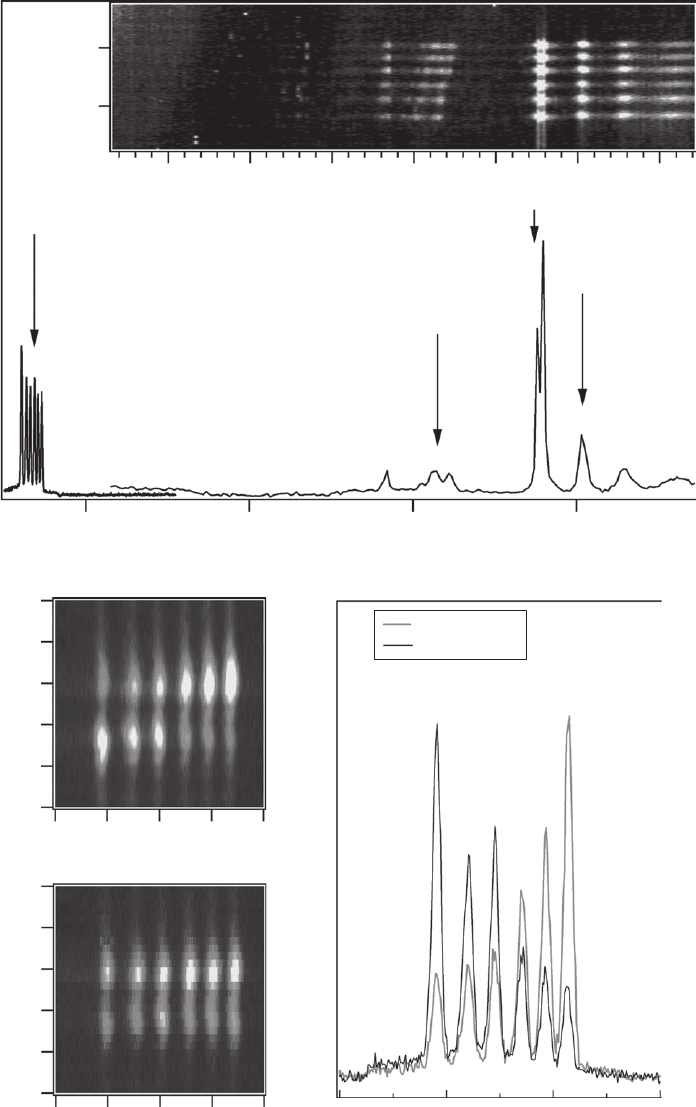
(a)
2087
2086
Det. energy (meV)
2100
Phonon replica
Ground state
PL intensity (arb. units)
2105 2110 2115 21202095 2125
2110 212021002090
Energy (meV)
e
1
e
2
Exct. energy (meV)
(c) (d)
E
exct
2117.95
E
exct
2117.74
2085.0 2086.0 2087.0 2088.0
Energy (meV)
PL intensity (arb. units)
2118.4
2118.2
2118.0
2117.8
2117.6
2117.4
2118.4
2118.2
2118.0
2117.8
2117.6
2117.4
2085.5 2086.0 2086.5 2087.0 2087.5
Detection ener
g
y (meV)
2086.0 2086.5 2087.02085.5 2087.5
Detection energy (meV)(b)
Excitation energy (meV)
Figure 14.9 (a) Experimental PL and PLE spectra of an Mn-doped quantum dot exciton. The inset shows the
contour plot of the multichannel PLE. (b) and (c) PLE contour plots for excited state e
1
obtained for co-polarized
(b) and cross-polarized (c) circular excitation and detection. (d) Resonant PL spectra obtained in co-polarized circular
excitation and detection for two different excitation wavelengths on e
1
.
CH014-I046325.indd 459CH014-I046325.indd 459 6/27/2008 4:29:52 PM6/27/2008 4:29:52 PM
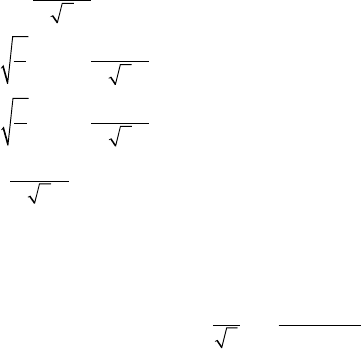
460 Handbook of Self Assembled Semiconductor Nanostructures for Novel Devices in Photonics and Electronics
strongly depends on both the wavelength and on the polarization of the excitation laser. This
dependence shows that under resonant excitation there is no complete spin relaxation of the
exciton–Mn complex during the lifetime of the exciton. As shown in Fig. 14.9d , this long spin
relaxation time combined with the fi ne structure of the excited states permits the selective cre-
ation of a given spin confi guration of the exciton–Mn complex by tuning the polarization and
wavelength of the excitation laser.
14.4 Geometrical effects on the optical properties of quantum dots doped with
a single magnetic atom
14.4.1 Infl uence of an anisotropic strain distribution
Several phenomena can lead to the mixing between light and heavy holes in QDs. First, the sym-
metry reduction due to the confi nement geometry of the dot has to be considered. In this case, a
hole band mixing appears through the non-diagonal terms of the Luttinger–Kohn Hamiltonian.
This mixing is responsible for the linear polarization rate observed in strongly confi ned quantum
wires [77] . A large wave function anisotropy is needed to reproduce the observed linear polariza-
tion [78] . Such anisotropy can only be obtained in a very elongated confi ning potential for the
holes with large barriers. This is inconsistent with the observation of huge linear polarization
rates in shallow CdTe/ZnTe QDs presenting a quite weak in-plane asymmetry as revealed by AFM
measurements [55] . Another origin of hh–lh mixing is the coupling of the X and Y valence band
states produced by the microscopic arrangement of chemical bonds at heterointerfaces [79] . This
contribution is expected to be weak in fl at self-assembled QDs with almost symmetric interfaces.
As we will see in the following, an effi cient mixing can arise from the anisotropic relaxation
of strains in the QDs plane. Infl uence of strains on hole states has been intensively studied in
quantum wells. Two main effects have been demonstrated, namely the variation of the gap due
to hydrostatic strains and the hh–lh degeneracy lift due to biaxial strains. We will show that in
QDs the strain distribution can also be responsible for a strong lh–hh mixing. This mixing has
striking effects on the hole spin anisotropy.
In bulk semiconductors, the spin orbit interaction is responsible for splitting the hole states. We
only consider here the lowest energy holes with angular momentum j 3 / 2. These j , j
z
states
can be simply defi ned using orbital ( X , Y , Z ) and spin ( ↑ , ↓ ) eigenvectors:
|3 / 2 , 3 / 2
2
|3 / 2 , 1 / 2
2
3
6
|3 / 2 , 1 / 2
2
3
〉↑
〉↑↓
〉↓↑
XiY
Z
XiY
Z
X
iY
XiY
6
|3 / 2 , 3 / 2
2
〉↓
(14.3)
Using these notations, the Bir–Pikus Hamiltonian describing the infl uence of the strain on the
valence band structure is written:
Ha bj j
d
jj jj
cp
BP v ii
i
ii
i
ixy
xy yx
εε ε
∑∑
⎛
⎝
⎜
⎜
⎜
⎜
(1/3)
2
3
2
..
22
⎞⎞
⎠
⎟
⎟
⎟
⎟
(14.4)
where the abbreviation c.p. is used for circular permutation over x , y and z corresponding to the
crystal axes. The matrices of the angular momentum operator
j
can be found in [69] .
ε
ij
denotes the ij component of the strain tensor and a
ν
, b and d are the deformation potentials for
CH014-I046325.indd 460CH014-I046325.indd 460 6/27/2008 4:29:54 PM6/27/2008 4:29:54 PM

Probing and Controlling the Spin State of Single Magnetic Atoms in an Individual Quantum Dot 461
the valence band. Using the hole formalism, J. Allègre et al. found a
ν
0 . 9 1 e V, b 0.99 eV and
d 2.76 eV for CdTe [73] .
While growing CdTe on ZnTe, CdTe is compressed in the growth plane and distended in the
growth direction. CdTe QDs form by deformation of a two-dimensional layer induced by strain
relaxation [45] . In this formation mechanism, both elastic and inelastic strain relaxations are
involved and one expects each QD to probe a different local in-plane strain distribution. When
studying a particular QD, one has to consider a particular set of values for ε
ij
. In the following, we
will mainly consider the effects of strain anisotropy in the growth plane and describe the strain
on each QD by an average value of ε
xy
and ε
xx
ε
yy
. A non-zero value of the volume average ε
ij
can result from a local deformation of the lattice induced by neighbouring QDs or dislocations.
In this approximation, the Bir and Pikus Himiltonian is reduced to a block-diagonal matrix in the
( 3 / 2 , 1 / 2 , 1 / 2 , 3 / 2) basis:
H
PQ R
RPQ
PQ R
RPQ
BP
†
†
⎛
⎝
⎜
⎜
⎜
⎜
⎜
⎜
⎜
⎜
⎜
⎜
⎜
⎜
⎜
⎞
⎠
⎟
⎟
⎟
⎟
⎟
⎟
⎟
⎟
⎟
⎟
⎟
⎟
⎟
⎟
⎟
(14.5)
with
Pa
Qb
Rid b
vii
i
xx yy
zz
xy xx yy
ε
εε
ε
εεε
∑
⎛
⎝
⎜
⎜
⎜
⎜
⎞
⎠
⎟
⎟
⎟
⎟
()
2
3
2
.
(14.6)
Using the hh band as the origin of the energies in the valence band, the strain Hamiltonian can
be rewritten as:
H
e
e
e
e
BP
s
i
i
lh
lh
i
s
i
S
S
S
S
0
0
2
2
2
2
ρ
ρ
ρ
ρ
θ
θ
θ
θ
−
′
′
′
′
⎛
⎝
⎜
⎜
⎜
⎜
⎜
⎜
⎜
⎜
⎜
⎜
⎜
⎜
Δ
Δ
⎜⎜
⎜
⎜
⎜
⎞
⎠
⎟
⎟
⎟
⎟
⎟
⎟
⎟
⎟
⎟
⎟
⎟
⎟
⎟
⎟
⎟
⎟
⎟
⎟
⎟
.
(14.7)
This notation allows us to introduce useful parameters to describe the strain effects, namely the
light–heavy hole splitting Δ
lh
, the strain coupling amplitude ρ
s
and the strain-induced anisotropy
axis in the QD plane defi ned by the angle θ
s
with respect to the x (100) axis. In the following, we
will defi ne angles relative to the (110) axis corresponding to the cleaved edge of the sample. We
thus introduce the new angle θ
s
θ
s
45º. Because of the strain-induced VBM described by the
Hamiltonian (Eq. 14.7), the general form for the lowest energy hole states is:
| ( )| 3/2 ( )| 1/2ϕχ χ
hhh
lh
hh
lh
r
w
w
r
〉∝ 〉 〉
(14.8)
where w
lh(hh)
is the probability of the hole being light (heavy) and
Xr
lh hh()
()
its envelope function.
Considering now single Mn-doped QDs, the sp–d exchange interactions between the confi ned
carriers and the single Mn atom are responsible for a peculiar fi ne structure of the emission [4] .
It has been demonstrated that the hole–Mn spin interaction is of prime importance in this fi ne
structure, because of its energy range and above all because of the spin anisotropy of the hole
[67, 68] . It appears clearly that a valence band mixing will have dramatic consequences on the
emission fi ne structures of Mn-doped QDs. In the heavy-hole approximation, a hole acts on the
CH014-I046325.indd 461CH014-I046325.indd 461 6/27/2008 4:29:54 PM6/27/2008 4:29:54 PM
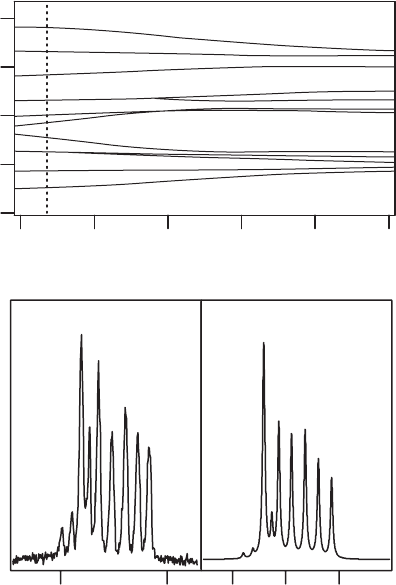
462 Handbook of Self Assembled Semiconductor Nanostructures for Novel Devices in Photonics and Electronics
Mn spin as an effective magnetic fi eld applied along the growth axis, lifting its spin degeneracy. If
a mixing of heavy and light holes is introduced, one has to consider a system of coupled spins in
which hole–Mn spin fl ips become possible.
One can fi nd a signature of the valence band mixing in the emission spectra of neutral
single Mn-doped QDs [69] . In an Mn-doped QD, the ground state of the exciton is composed of six
bright energy levels and six dark energy levels resulting from the coupling of bright excitons and
dark excitons with the six projections of the Mn spin. For a given exciton spin ( 1 or 2), the six
Mn spin projections have different energies. In this system, the hole spin interacts with both the
Mn spin and the electron spin. The effect of an increasing valence band mixing on the excitonic
emission spectrum of a QD is presented in Fig. 14.10a . Parameters are chosen to reproduce the
features of QD5 emission spectrum plotted on Fig. 14.10b : the e-Mn exchange integral I
e M n
is
set to 70 μ eV; the splitting between bright and dark exciton δ
0
is chosen equal to 550 μ eV, equally
divided among the long range and short range e–h exchange interaction. Other parameters are
the same as in the previous charged exciton calculation.
1.0
0.5
0.0
0.0 0.2 0.4 0.6 0.8 1.0
(a)
p/
lh
Energy (meV)
1.0
Exp.
Calc.
PL intensity (arb. units)
2037 2039 0
Energy (meV) Energy (meV)(c)(b)
11
0.5
Figure 14.10 (a) Dependence of the exciton–Mn energy spectrum on the strength of the valence band mixing
ρ / Δ
lh
. The dotted line corresponds to the situation of QD6 ( ρ / Δ
lh
0.07). (b) and (c) are the experimental and
calculated emission spectra of QD6.
14.4.2 Infl uence of the shape anisotropy
Let us consider now the infl uence of the electron–hole exchange interaction. We have seen in the
case of non-magnetic QDs that, in fi rst approximation, the only effect of the valence band mixing
on the short range e–h exchange is to couple bright exciton states together. For magnetic QDs,
bright states associated with the same Mn spin projection are thus coupled. This coupling mainly
concerns the energy levels associated with Mn spin projections 1/2 because they are only
CH014-I046325.indd 462CH014-I046325.indd 462 6/27/2008 4:29:54 PM6/27/2008 4:29:54 PM
Probing and Controlling the Spin State of Single Magnetic Atoms in an Individual Quantum Dot 463
slightly split by the exciton–Mn exchange interaction. An increase of the valence band mixing
will thus open a slight gap in the middle of the bright exciton fi ne structure (around 0.25 meV in
Fig. 14.10a ).
Another gap appears on the low energy side of the structure because of the hole–Mn inter action.
As a matter of fact, simultaneous hole–Mn spin fl ips couple bright and dark states associated with
consecutive Mn spin projections. The exciton–Mn exchange interaction induces an overlap of the
bright and dark exciton fi ne structure. States coupled by h–Mn spin fl ips are therefore quite close
to each other and an increase in the VBM, that is to say an increase in the h–Mn spin fl ip effi ciency,
will open a gap between them. This can be observed in Fig. 14.10a around 0.1 meV. Finally, one
may note once again that the overall splitting of the structure decreases as the VBM increases
because of the decrease of the weight of the heavy-hole in the exciton ground state.
Such coupling between bright and dark excitons is observed in the spectrum of QD6 presented
in Fig. 14.10b . In this QD, the valence band mixing is quite weak and the gaps induced by the e–h
exchange and the h–Mn exchange can be hardly resolved in the exciton spectrum. Nevertheless,
the h–Mn spin fl ips-induced bright–dark coupling is large enough to give non-negligible oscillator
strengths to the dark states. Three “ dark ” states are then observed in the emission spectrum. The
value ρ
s
/ Δ
lh
can be estimated at 0.07. Using this parameter we can calculate the QD6 exciton emis-
sion spectrum. The result is plotted in Fig. 14.10c . It has been shown in previous work [4] that the
exciton–Mn system is partially thermalized during the exciton lifetime. This results in an increase
in the intensity of the lines as their energy decreases. In the calculation we thus consider that the
system has relaxed and that it is characterized by an effective spin temperature T
eff
depending both
on the phonon bath and on the hot carrier gas produced by the laser excitation. In Fig. 14.10c
T
eff
15 K. With this effective temperature, “ dark ” states appear in the calculated spectrum but
their intensity is weaker than in the experiment. Moreover, comparing the intensities of the bright
lines in the calculation and in the experiment, we note that we cannot fi t the data with an effective
temperature smaller than 15 K in order to increase the “ dark ” state’s intensity. These features show
that we should not consider a total thermalization in the exciton–Mn system: if the spin relaxation
is partially blocked, it is diffi cult to thermalize the system. As bright and dark excitons are created
with the same generation rate, the intensities of the associated transitions can be comparable even
though they have different oscillator strengths. This is particularly the case under weak excitation
conditions where the infl uence of the hot carrier gas spin reservoir is reduced.
We fi nally consider the neutral exciton fi ne structure of a single Mn-doped QD that presents an
anisotropic in-plane shape (QD7 presented in Fig. 14.11 ). Effects of the long range electron–hole
exchange interaction on the emission spectrum of a single Mn-doped QD were discussed in a former
letter [70] . Nevertheless, details of the polarization properties were not analysed. Here, we detail
these polarization features and show that the VBM is once again necessary to explain them. Figure
14.11 presents the linear polarization dependence of the emission spectrum of QD7. The experi-
mental spectrum shows the main characteristics of a quite strong VBM as detailed in Fig. 14.11a .
The spectrum presents an overall linear polarization rate of about 25% orientated at θ
s
1 1 0 °
from the cleaved edge of the sample and dark states appear on the low energy side of the structure.
Two gaps can also be observed: one between the two fi rst main lines and the other between the
third and the fourth lines. However, if these peculiarities were only due to the combined effect of
the VBM and short range e–h exchange, one could expect the third and the fourth lines to be polar-
ized parallel and perpendicular to the strain direction (110°). It is not the case and, surprisingly, the
emission spectrum also presents non-orthogonal linear polarization directions.
These polarization directions are the signature of a competition between a valence band mix-
ing and long range electron–hole exchange interaction. The calculation of the emission spec-
trum of QD7 (right panel of Fig 14.11 ) gives a good agreement with the experiment using the
following parameters: I
e
Mn
6 0 μ eV, I
h
Mn
1 3 5 μ eV,
δδ
00
300
lr sr
μeV
, δ
2
4 5 0 μ eV,
Δ
lh
3 0 m e V, ρ
s
/ Δ
lh
0.25 and T
eff
20 K. The strain direction and the dot shape direction
must be roughly perpendicular (80°) to fi t the experiment. The main features of QD7 emission
are well reproduced as presented in Fig. 14.11 .
In anisotropic QDs, the interplay between the electron–hole and exciton–Mn exchange inter-
actions is confi rmed by magneto-optical measurements ( Fig. 14.12 ). The typical Zeeman split-
ting of the six lines is clearly observed in the data at all fi elds, with a strong intensity gradient at
the highest fi elds resulting from a rather strong Mn spin polarization. For this clearly anisotropic
CH014-I046325.indd 463CH014-I046325.indd 463 6/27/2008 4:29:55 PM6/27/2008 4:29:55 PM
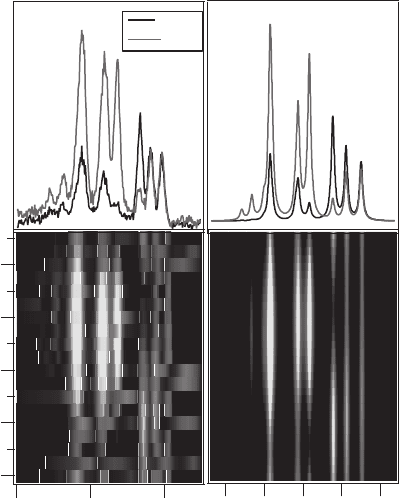
464 Handbook of Self Assembled Semiconductor Nanostructures for Novel Devices in Photonics and Electronics
dot, the central gap in the emission structure is maintained in both circular polarizations, with
a small quadratic diamagnetic energy shift. This behaviour is explained as follows: the dot ani-
sotropy leads to successive anticrossings of the 1 bright exciton states associated with given
Mn spin projections ( 1/2, 3/2 and 5/2) as a function of magnetic fi eld – As B increases,
transitions associated with the J
z
1 exciton shift up in energy whereas the J
z
1 transi-
tions shift down. The anisotropic part of the electron–hole exchange interaction mixes succes-
sively the J
z
1 exciton states associated with S
z
1 / 2, then with S
z
3 / 2 and fi nally
with S
z
5 / 2 at successively higher B. For QD3, these anticrossings are observed successively
at 2.5, 7 and 11 T.
To understand fully the rich magnetic behaviour of these anisotropic QDs, we calculated the
optical transitions under magnetic fi eld by diagonalizing the complete Hamiltonian of the electron-
heavy hole–Mn system (including the exchange, Zeeman and diamagnetism Hamiltonians).
Calculated transitions are presented in Fig. 14.12b . The fi tted Landé factors of the electron
(g
e
1.1), the hole (g
h
0.3) and the Mn atom (g
Mn
2.0), the splitting between J
z
1 and
J
z
2 excitons ( 1 meV) and the diamagnetic factor ( γ 2 . 4 5 μ eV T
2
) agree well with pre-
vious work [4, 29, 56] . Parameters δ
2
and δ
Mn
were adjusted to fi t the zero fi eld data, as explained
earlier.
Comparison between calculation and data explains most of the details of the magneto-optic
properties. In particular, around 7 T, the central gap is perturbed in both circular polarizations.
In σ , this is due to anticrossings induced by the mixing of s
e
1/2, j
hz
3/2, S
z
states and
1/2, 3/2, S
z
1 states by the electron – Mn exchange [4] , i.e. corresponding to simultane-
ous spin-fl ips of electron and manganese spins. In σ polarization, Fig. 14.12b shows that the
line of second lowest energy crosses the central gap as an essentially non-radiative transition.
This implies a mixing of 1 / 2, 3 / 2 , 3 / 2 and 1 / 2 , 3 / 2, 1 / 2 . This is a second-order
mixing involving both mixing of 1 / 2, 3 / 2, 1 / 2 and 1/2, 3/2, 3/2 by the e–Mn
160
120
80
40
0
Analysis angle (°)
204520442043
Ener
g
y (meV)
1.0 0.5 0.0 0.5 1.0
Ener
g
y (meV)
PL intensity. (arb. units)
20°
130°
Exp. Calc.
Figure 14.11 Experimental and calculated polarization resolved photoluminescence of QD6. The intensity maps
present the dependence of the emission on the analyser angle. The emission spectrum are presented for orthogonal
linear analyser directions (red and black curves).
CH014-I046325.indd 464CH014-I046325.indd 464 6/27/2008 4:29:55 PM6/27/2008 4:29:55 PM
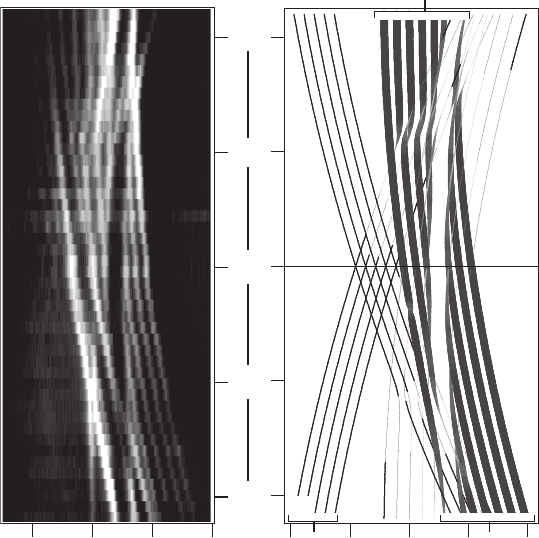
Probing and Controlling the Spin State of Single Magnetic Atoms in an Individual Quantum Dot 465
exchange and mixing of 1 / 2, 3 / 2, 3 / 2 and 1 / 2, 3 / 2, 3 / 2 by the anisotropic e–h
exchange; that is, the e–Mn exchange induces a mixing of states mediated by the anisotropy-
induced coupling.
To summarize these geometrical effects, as for as this study is concerned an anisotropic stain
distribution in the growth plane and a QD-shaped anisotropy induce a valence band mixing
which strongly modifi es the emission spectra of single Mn-doped QDs. The main observed effects
are: (i) the appearance of anticrossings related to possible Mn–hole spin-fl ips, (ii) the separation
of the six line structures into two sets of lines partially polarized, and (iii) the variation of the
linear polarization directions which are no longer perpendicular to the exciton fi ne structure of a
given QD. The last feature clearly evidences the competition between two types of anisotropy, one
coming from the confi nement potential (shape anisotropy) and one coming from the local strain
distribution into the dot.
14.5 Carrier-controlled spin properties of a single magnetic atom
14.5.1 Carrier-induced spin splitting of a single Mn atom in a quantum dot
Investigating both the biexciton and the exciton transitions in the same Mn-doped QD, we ana-
lyse the impact of the Mn–exciton exchange interaction on the fi ne structure of the QD emission.
2046204520442043
Ener
g
y (meV)
210
12
Ener
g
y (meV)
10 T
0 T
10 T
QD3
(a)
σ−
σ
J
z
2J
z
1
J
z
1
(b)
Figure 14.12 (a) Intensity map of magnetic fi eld dependence of the emission spectrum of an asymmetric
Mn-doped dot QD3, for circular polarization σ and σ . (b) Optical transitions obtained from the diagonalization
of the spin Zeeman diamagnetism Hamiltonian in the subspace of the 24 heavy-hole exciton and Mn spin
components; line thickness and colour scale for σ , σ are proportional to absolute value of the projection of the
exciton state on the J
z
1 , 1 exciton, respectively (green low intensity, blue high intensity). The two
transitions which are forbidden at all magnetic fi elds (| J
z
2, S
z
5 / 2 ) are not plotted.
CH014-I046325.indd 465CH014-I046325.indd 465 6/27/2008 4:29:57 PM6/27/2008 4:29:57 PM
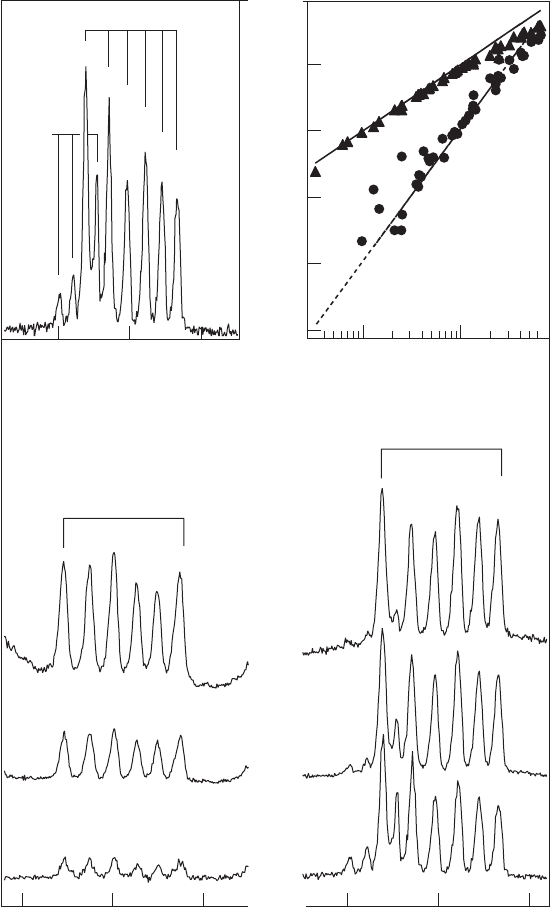
466 Handbook of Self Assembled Semiconductor Nanostructures for Novel Devices in Photonics and Electronics
A single electron–hole pair is enough to induce a spontaneous splitting of the exciton–Mn system
and a slight polarization of the Mn spin distribution. The injection of a second electron–hole pair
cancels the exchange interaction with the Mn ion and the Mn spin degeneracy is almost com-
pletely restored.
In the following, we will compare the fi ne structure of the exciton and biexciton in a single Mn-doped
QD. Figure 14.13 shows the emission spectra of one of these Mn-doped QDs for various excitation
10
0
10
1
10
2
10
3
10
4
4 6 8
10
3
2 4 6 8
10
4
2 4 6
I
tot
I
X
I
X
2
(arb. units)
αI
tot
αI
tot
2
X–Mn
X
2
–Mn
PL intensity (arb. units)
202820272026
Energy (meV)
203920382037
80
μ
W
200
μ
W
X–Mn
X
2
–Mn
3
PL intensity (arb. units)
PL intensity (arb. units)
203920382037
Energy (meV)
...
X
b
–Mn
X
d
–Mn
B 0T
T 5K
700
μ
W
Figure 14.13 PL spectra of a single Mn-doped QD for different excitation intensity. X–Mn denotes the exciton–Mn
emission while X
2
–Mn corresponds to the recombination of the two-exciton–Mn (biexciton) states. The insets give a
detail of the X–Mn emission spectra at low excitation density (X
b
–Mn corresponds to the bright excitons and X
d
–Mn
corresponds to the dark excitons) and the evolution of the integrated intensities of X–Mn and X
2
–Mn as a function
of the total emission intensity.
CH014-I046325.indd 466CH014-I046325.indd 466 6/27/2008 4:30:01 PM6/27/2008 4:30:01 PM
Probing and Controlling the Spin State of Single Magnetic Atoms in an Individual Quantum Dot 467
densities. At low excitation, the spectrum is dominated by the six line fi ne structure (labelled
X–Mn) which is attributed to a confi ned exciton interacting with a single Mn atom. The three
additional lines, observed at low excitation intensity in the low energy side of the emission struc-
ture (enlarged view in the inset of Fig. 14.13 ), are due to the interaction of the dark exciton
states ( J
z
2) with the Mn
2
ion [69] . The PL contribution of the dark states is enhanced by
the relaxation of the exciton–Mn system towards the low-energy levels. This relaxation is also
responsible for the asymmetry in the emission intensity distribution of the bright states at low
excitation intensity [4] .
On increasing the excitation intensity, a new structure of six lines, labelled X
2
–Mn, appears
10.9 meV below the exciton lines. Its intensity increases quadratically with the excitation and its
structure reproduces the spectral pattern of X–Mn. Such intensity dependence has been observed
in various QD systems and is regarded as a fi ngerprint of exciton and biexciton emission [62, 63] .
The energy difference between the X–Mn and the X
2
–Mn transitions (10.9 meV) corresponds to
the typical binding energy of the biexciton measured in non-magnetic CdTe/ZnTe QDs [62] . We
have also noticed that, as the excitation intensity increases, the contribution of the transitions
associated with the dark exciton states progressively vanishes. This evolution, already observed
in non-magnetic QDs [62] , is due to the longer lifetime of the dark exciton states. Because of
this difference in lifetime, for a given non-resonant excitation intensity, the probability to cre-
ate a biexciton with two dark excitons is larger than with two bright excitons. The formation
of the biexciton acts then as an effi cient recombination channel for the dark exciton states and
decreases their direct PL contribution.
Magneto-optic measurements confi rm that the exciton and the biexciton transitions coming
from the same Mn-doped QD are observed. The magnetic fi eld dependence of the exciton–Mn and
biexciton–Mn transition energies are presented as a contour plot in Figure 14.14 . For X–Mn, six
lines are observed in each circular polarization. Their energy follows the Zeeman and diamagnetic
shift of the exciton in non-magnetic QDs [4] . The excitonic transitions present also a rich fi ne
structure mainly characterized by a series of fi ve anticrossings observed in σ polarization around
7 T. These anticrossings come from the mixing of the bright and dark exciton states [4] induced
by a simultaneous spin fl ip of the electron and Mn
2
ion. The fi ne structure of the exciton–
Mn and the biexciton–Mn systems under magnetic fi eld present a perfect mirror symmetry. The
anticrossings observed on the high energy lines of X–Mn in σ polarization are symmetrically
observed on the low energy lines and in σ polarization for X
2
–Mn (circles in Fig. 14.14 ) [70] .
As it appears in the contour plot presented in Fig. 14.14 , the relative intensities of the six emis-
sion lines observed in each circular polarization strongly depend on the applied magnetic fi eld.
The emission intensity, which is almost equally distributed over the six emission lines at zero fi eld,
is concentrated on the high-energy side of the σ emission and on the low-energy side of the σ
emission at high magnetic fi eld. The intensity distribution is similar for X–Mn and X
2
–Mn.
In a QD, the biexciton ground state is a spin-singlet state ( J 0) and cannot be split by the
magnetic fi eld or the spin interaction part of the carriers–Mn Hamiltonian [71] . In this model,
the creation of two excitons in the same QD cancels all the exchange interaction terms with the
Mn
2
ion. Thus, the fi ne structure of the biexciton–Mn transitions is controlled by the fi nal state
of the recombination of the biexciton, i.e. the eigenstates of the exciton–Mn coupled system.
The optical transitions directly refl ect this mirror symmetry of the energy levels. Moreover, the
intensity distribution of the X–Mn and X
2
–Mn transitions are both controlled by the spin polari-
zation of the Mn
2
ion. The spin of the Mn
2
ion is orientated by the applied magnetic fi eld. At
high fi eld, when the biexciton recombines, the probability of leaving in the QD an exciton cou-
pled with a Mn spin component S
z
5/2 is enhanced. Therefore, in the two-photon cascade,
occurring during the recombination of a biexciton, the polarization of the Mn spin will enhance
the intensity of the high-energy biexcitonic transition in σ polarization and the one in the
low-energy single-exciton transition in σ polarization. Symmetrically, the emission intensity is
concentrated in the low-energy biexcitonic transition in σ polarization and in the high-energy
single-exciton transition in σ polarization.
In summary, the analysis of the biexciton fi ne structure shows that the optical injection of a con-
trolled number of carriers in an individual QD allows control of the spin splitting of a single mag-
netic ion. The exchange interaction with a single exciton acts as an effective local magnetic fi eld
CH014-I046325.indd 467CH014-I046325.indd 467 6/27/2008 4:30:02 PM6/27/2008 4:30:02 PM
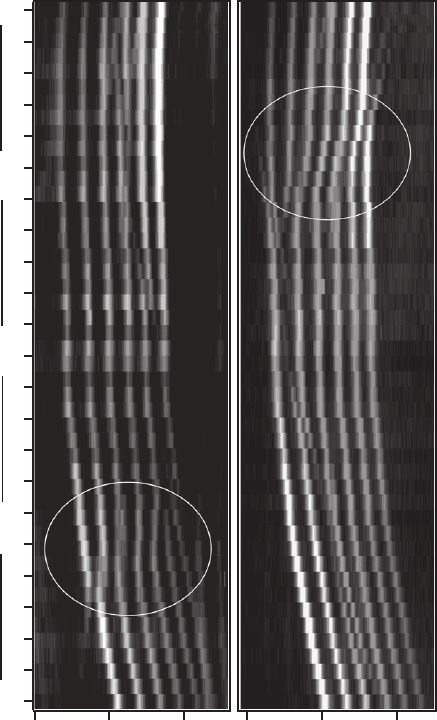
468 Handbook of Self Assembled Semiconductor Nanostructures for Novel Devices in Photonics and Electronics
which splits the Mn levels in zero applied magnetic fi eld. The injection of a second exciton almost
cancels the carriers – Mn exchange interaction and the Mn spin splitting is signifi cantly reduced.
14.5.2 Electrical control of a single Mn atom in a quantum dot
CdTe/ZnTe QDs are p -type modulation doped by the transfer of holes from the p -doped ZnTe sub-
strate and from surface states that act as acceptors [60, 61] . The occupation of the QDs by holes
can be controlled by an external bias voltage V on an aluminium Schottky gate with respect to
a back contact on the p -type substrate. The bias-dependent emission of a non-magnetic QD and
a Mn-doped QD is presented in Fig. 14.15 . For increasing V , the surface level states are shifted
below the ground hole level in the QDs which results in the single hole charging of the dots. The
optically generated excitons then form charged excitons with the bias-induced extra hole in the
QD. At zero bias or negative bias, the Fermi level is above the ground state and the QDs are likely
to be neutral. However, the separated capture of photo-created electron or holes can sometimes
charge the dots so that weak contributions of X
or X
are observed in the zero bias spectra.
2039
20382037
X–Mn
202820272026
X
2
–Mn
σ
σ
Energy (meV)Energy (meV)
11 T
11 T
0T
Figure 14.14 Intensity contour plot of the magnetic fi eld dependence of the excitonic and biexcitonic transitions
of a single Mn-doped QD. The bright areas correspond to the high PL intensity. The anticrossings observed for the
exciton are symmetrically reproduced on the biexciton transitions.
CH014-I046325.indd 468CH014-I046325.indd 468 6/27/2008 4:30:02 PM6/27/2008 4:30:02 PM
